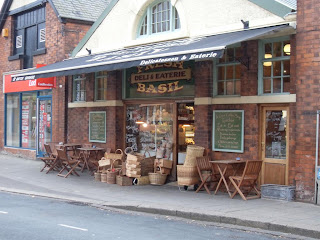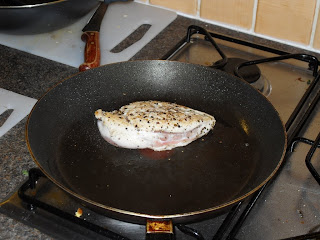Gosh, it's been a while since I've posted anything! Sorry! Things have been a bit hectic just recently with two weddings and much to do at work. Anyway, I thought it was time for another post.
One of the weddings I was at was in the small town of Belper, in Derbyshire. A quick search of the Internet before I went revealed that a cafe called 'Fresh Basil' was a good place to eat, so I thought I had to check it out:

Inside was a wonderful Deli, with all kinds of meat and cheese for sale. There were also a number of tables set out, in what was obviously the cafe part of the establishment. I was very keen to have some kind of local, Derbyshire speciality if possible, so I was delighted when looking over the menu I spotted "Hot Derbyshire Salad". I was, in fact, about 10 minutes too late for ordering food, but to their great credit, they made it for me anyway, which I think says a lot. It's a shame that this level of customer service isn't more prevalent. Anyway, the dish that arrived was truly something to behold:

It's a mix of hot black pudding and bacon, with sliced apple, served on a bed of leaves with a balsamic vinegar dressing. It was really good! I have to say, I'm not always the biggest fan of black pudding, but here it worked really well. The sharpness of the fresh apple perfectly balanced the heaviness of the black pudding.
Anyway, I can most heartily recommend this place, if you should find yourself in Derbyshire, near to Belper. It was definitely worth the visit for me. The wedding was good to, of course! :-)












 To my great delight, I noticed while watering last night that some of my tomatoes are starting to ripen! It's such a great feeling, watching plants grow knowing that you're going to be able to enjoy the fruits (literally!) of your labour very soon. I never cease to be amazed at how few people even try to grow their own, it's great fun and requires very little space. I only have a small patio and yet I can still grow a decent quantity of tomatoes, even if they are now a little on the rampant side:
To my great delight, I noticed while watering last night that some of my tomatoes are starting to ripen! It's such a great feeling, watching plants grow knowing that you're going to be able to enjoy the fruits (literally!) of your labour very soon. I never cease to be amazed at how few people even try to grow their own, it's great fun and requires very little space. I only have a small patio and yet I can still grow a decent quantity of tomatoes, even if they are now a little on the rampant side:


































